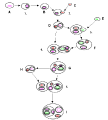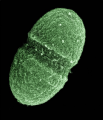| Line 28: | Line 28: | ||
<gallery> | <gallery> | ||
Image:A representation of the endosymbiotic theory; wikipedia.png|A representation of the endosymbiotic theory. Source: wikipedia | Image:A representation of the endosymbiotic theory; wikipedia.png|A representation of the endosymbiotic theory. Source: wikipedia.org | ||
Image:Enterococcus_faecalis_bacterium,_which_lives_in_the_human_gut.png| Enterococcus faecalis bacterium, which lives in the human gut. Source: wikipedia | Image:Enterococcus_faecalis_bacterium,_which_lives_in_the_human_gut.png| Enterococcus faecalis bacterium, which lives in the human gut. Source: wikipedia.org | ||
</gallery> | </gallery> | ||
Revision as of 22:05, 29 November 2015
I love the fact that human genomes can be found in only about 10 percent of all the cells that occupy the mundane space I call my body; the other 90 percent of the cells are filled with the genomes of bacteria, fungi, protists, and such, some of which play in a symphony necessary to my being alive at all, and some of which are hitching a ride and doing the rest of me, of us, no harm. — Dona Haraway
Synthesis of bacterial cellulose/paper from kombucha scoby
Human microbiota
“During the course of the evolution of mitosis, photosynthetic plastids (themselves derived from prokaryotes) were symbiotically acquired by some of these protozoans to form the eukaryotie algae and the green plants.” (Margulis 1966)
“Symbiogenesis, or endosymbiotic theory, is an evolutionary theory that explains the origin of eukaryotic cells from prokaryotes (1.5 billion years ago). It states that several key organelles of eukaryotes originated as a symbiosis between separate single-celled organisms (Lynn Margulis theory)” (Harraway 2008)
“Species interdependence is the name of the worlding game on earth, and that game must be one of response and respect. That is the play of companion species learning to pay attention. Not much is excluded from the needed play, not technologies, commerce, organisms, landscapes, peoples, practices.” (Harraway 2008)
“Organisms are ecosystems of genomes, consortia, communities, partly digested dinners, mortal boundary formations.” (Harraway 2008)
“Because I become with dogs, I am drawn into the multispecies knots that they are tied into and that they retie by their reciprocal action. My premise is that touch ramifies and shapes accountability.” (Haraway 2008)
Chthulucene
Chthulucene is a multispecies assemblages that include people within past, present, and future. The idea of Haraway is that Anthropocene marks rather a boundary and not an epoch as widely accepted.
“Of course, from the start the greatest planetary terraformers (and reformers) of all have been and still are bacteria and their kin, also in inter/intra-action of myriad kinds (including with people and their practices, technological and otherwise).” (Haraway 2015)
“Kin is an assembling sort of word. All critters share a common “flesh,” laterally, semiotically, and genealogically.” (Haraway 2015)
Artworks
Bibliography
- NIH Human Microbiome Project defines normal bacterial makeup of the body (2012)
- Donna Haraway (2015). "Anthropocene, Capitalocene, Plantationocene, Chthulucene: Making Kin" in Environmental Humanities, vol. 6, pp. 159-165
- Donna Haraway (2008) WHEN SPECIES MEET
- Lynn Margulis (1966). "On the Origin of Mitosing Cells" in J. Theoret. Biol. (1967) 14, 225-274









